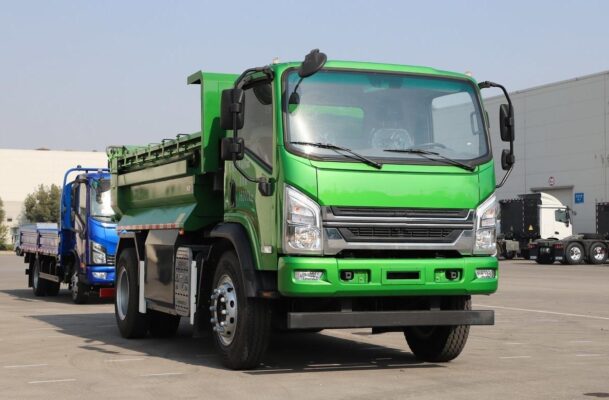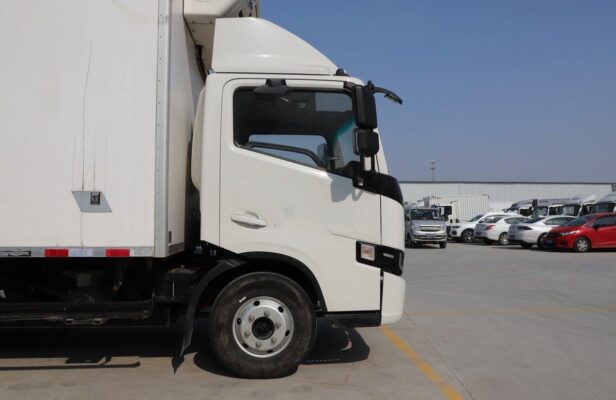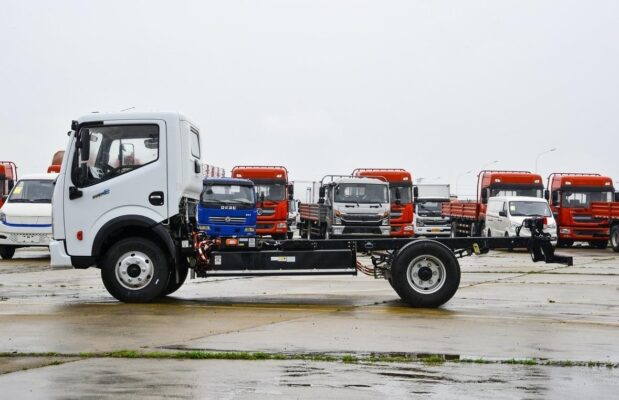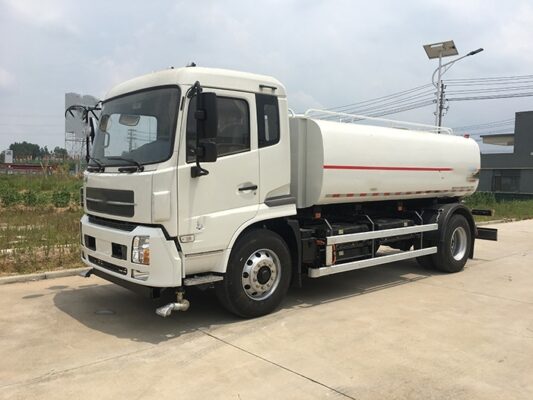Electric Truck News
Charging VS Battery Swap: Is Buying Batteries More Cost-effective than Renting Them?
Posted on by Electric Trucks
In 2022, the sales of electric heavy-duty trucks experienced yet another explosive growth, reaching 23,488 units. Among them, battery swap heavy-duty trucks, driven by policies, witnessed a remarkable increase in sales, and their proportion surpassed that of charging heavy-duty trucks for the first time. Surprisingly, Sany Heavy Truck without the advantage of policies (primarily promoting charging), emerged as the leader in annual sales with 4,129 units, outpacing the second place by 1,164 units.
What lies behind such a contrast? Which option is better between charging heavy-duty trucks and battery swap heavy-duty trucks? How can one balance various factors such as individual needs and usage environment to achieve the transportation goals of being green, low-carbon, efficient, and highly profitable? With these questions in mind, we visited Sany Heavy Truck to uncover the reasons.

Battery Swap (Renting Electric Trucks) is Easier for Vehicle Purchase, but Charging Has a Lower Overall Operating Cost
Firstly, the battery cost of charging heavy-duty trucks is relatively lower compared to battery swap heavy-duty trucks. During operation, charging heavy-duty trucks employ large-scale lithium-ion battery packs. Due to their smaller quantity and larger specifications, the cost per unit of electricity is lower than the battery cells used in battery swap heavy-duty trucks.
For battery swap heavy-duty trucks, to ensure 24-hour operation, a significant number of battery cells are necessary. These battery cells have relatively smaller specifications and a relatively higher cost per unit of electricity.
Secondly, the construction cost of charging facilities is lower. The establishment of charging piles is relatively straightforward, merely requiring the connection of the power supply and the installation of charging equipment. Additionally, the charging technology is relatively mature and stable, and the equipment cost is also lower. However, the construction of battery swap stations demands a larger site and higher investment costs. Moreover, the battery swap technology is more complex than the charging technology, entailing higher equipment costs, operating costs, and maintenance costs.
Take Sany’s own charging and battery swap equipment as an example: Under ideal conditions, a battery swap station can serve 50 vehicles. Thus, calculated based on the standard of 50 vehicles, the current cost of each charging pile is approximately 65,000 yuan, while the construction of a battery swap station requires about 7.5 million yuan. This implies that on average, the cost of building charging piles is more than 50% lower than that of building battery swap stations.
Furthermore, charging heavy-duty trucks face relatively fewer geographical restrictions. Charging piles can be conveniently installed in diverse locations. In contrast, battery swap stations require the construction and maintenance of more physical facilities. In areas with stringent environmental restrictions, charging heavy-duty trucks are evidently more convenient.
If battery swap heavy-duty trucks are utilized by renting batteries, the cost will be even higher. Although the upfront purchase cost is essentially the same as that of fuel vehicles, to recoup the cost, battery swap stations typically have higher electricity prices. Coupled with the cost of renting batteries, the final outcome is that the usage cost per kilometer amounts to about 3 yuan, and the usage cost per kilometer is 0.8 to 1 yuan higher than purchasing the entire vehicle, almost approaching the operating cost of fuel vehicles.
At the same time, vehicles without batteries cannot be transferred and registered as second-hand vehicles. In the later stage of the vehicle-battery separation model, it is practically impossible to resell. In contrast, charging heavy-duty trucks of this type do not encounter this predicament and often have a superior residual value for second-hand vehicles.
Perhaps some might argue that battery swap holds an efficiency advantage, and by making more trips, the money can be recuperated. In reality, this is not necessarily the case. Usually, a standard battery swap station can swap approximately 7 batteries simultaneously at a time. Subsequently, it is necessary to wait for the batteries to be fully charged before swapping.
If it is a battery swap station lacking proper management and maintenance, or if there are an excessive number of vehicles resulting in an insufficient supply of batteries, inevitable long waiting times for battery swap will occur. After all, waiting for more than an hour is not uncommon. And currently, the dual-gun fast charging time is only 1 to 1.5 hours. Therefore, the energy replenishment efficiency advantage of battery swap heavy-duty trucks is not absolute.
Many users in regions such as Hebei, Tianjin, and Xinjiang have affirmed the numerous advantages of charging heavy-duty trucks. For instance, after Qianxi Fuzhong Freight Transport Fleet purchased Sany charging heavy-duty trucks for the first time in 2021, their profit capacity has significantly improved, and their cash flow is more abundant. The serviced party, Jinxi Iron and Steel, has also achieved the goal of reducing carbon by 200,000 tons annually, attaining the highest domestic environmental protection performance standard, being rated as an A-level enterprise, and being recognized as a green factory in 2021 by the Ministry of Industry and Information Technology.
At present, this fleet has made repeat purchases three times, acquiring a total of 206 electric heavy-duty trucks. They are highly optimistic about the advantages of the convenient supporting facilities and low operating costs of Sany charging heavy-duty trucks and anticipate that the investment cost can be recouped within three years.
In summary, if viewed purely from the cost perspective, battery swap heavy-duty trucks (renting batteries) have a low entry threshold, similar to a low down payment for buying a house but with high mortgage costs; charging heavy-duty trucks have an advantage in comprehensive costs, and there is no vehicle scale limit, which is more user-friendly; battery swap heavy-duty trucks + self-built battery swap stations require a certain fleet scale and a longer time to achieve higher returns.

Charging Heavy-duty Trucks / Purchasing the Entire Vehicle is Easier to Achieve Scene Matching
In recent years, customer demands in the truck market have exhibited an increasingly diversified and individualized trend. Many main engine factories aspire to be able to deeply align with user usage scenarios, provide customized products that meet requirements, and assist users in reducing costs in vehicle-cargo matching to enhance their brand advantages.
However, among the current battery swap heavy-duty truck products in the market, very few can genuinely assist users in achieving vehicle-cargo matching. Most importantly, the products available in the market do not possess the core technologies of the “three major components”, namely batteries, motors, and electronic controls, all of which must rely on external providers. The usage conditions of users cannot be comprehensively understood, and the improvement and update of products by main engine factories are also somewhat limited.
Self-developing and manufacturing the entire vehicle offers the most significant benefit that the main engine factory can fully grasp the technology and conduct customized calibrations for specific scenarios or even a particular route. Against this backdrop, Sany Heavy Truck has invested 20 billion yuan to establish an exclusive electrification production base. The Magic Tower battery and MTB battery management system demonstrate its profound self-research capabilities.
At the same time, Sany Heavy Truck has also recruited over 100 software engineers, specializing in the development of vehicle control software technology to understand the vehicle transportation situation, identify operational issues, and provide solutions. Sometimes, merely through the OTA function, Sany Heavy Truck can calibrate and adjust the user’s vehicles, enhancing work efficiency.
The in-depth self-research and development of the entire vehicle technology also enables the upgrade speed of Sany electric heavy-duty trucks to surpass that of its counterparts. It is reported that a new product with a range of over 800 kilometers is about to be launched in May. Compared to the majority of products in the market that still have a range of approximately 200 kilometers, it can be regarded as a milestone offering.

Editor’s Note:
In general, charging heavy-duty trucks hold a cost advantage over battery swap heavy-duty trucks, but this advantage is currently primarily manifested in short-distance operation domains such as steel mills and mines. With the continuous advancement of technology, the operational mode of electric heavy-duty trucks is bound to undergo substantial changes. For example, Sany Heavy Truck’s forthcoming Jiangshan SE-437H, equipped with a 1165kW·h battery and a range of over 800 kilometers, is destined to trigger a significant revolution in the electric heavy-duty truck market and break the existing usage scenarios of electric heavy-duty trucks.
In conclusion, with the continuous intensification of environmental consciousness, the growth momentum of the electric truck market will persist. However, when choosing between charging heavy-duty trucks and battery swap heavy-duty trucks, it is essential to balance various factors such as one’s own needs and usage environment and select a suitable vehicle model to better achieve the transportation goals of being green, low-carbon, efficient. So here comes the question, if the range exceeds 800 kilometers, who will be more suitable between the two methods of ultra-long range + battery swap or ultra-long range + charging?

Now, let’s explore some additional considerations and potential future developments in this context:
The charging infrastructure is evolving rapidly. As more charging stations are built and charging technologies improve, the convenience and speed of charging heavy-duty trucks will likely increase further. This could tip the balance even more in favor of charging, especially for long-range applications.
The cost of battery production and battery swap technology might also change over time. If there are significant breakthroughs in battery manufacturing that reduce costs or if battery swap operations become more efficient and cost-effective, the equation could shift again.
Regulatory and policy factors can have a major impact. Governments might introduce incentives or mandates that favor one approach over the other, influencing both the economics and adoption rates.
The development of energy storage and grid integration technologies could also play a role. If the grid can better handle the load from large-scale charging of heavy-duty trucks or if there are innovative ways to store and distribute energy, this could affect the feasibility and cost of both charging and battery swap models.
From a sustainability perspective, the lifecycle assessment of batteries, including their production, use, and disposal, could become a critical factor in determining the overall environmental impact and cost-effectiveness of each option.
Finally, user behavior and preferences will continue to shape the market. Some users might prioritize the speed and convenience of battery swap, while others might be more sensitive to the total cost of ownership offered by charging. Understanding these diverse needs and providing flexible solutions could be the key for manufacturers and service providers in the future.
In the coming years, as the electric vehicle industry matures and technologies advance, the choice between charging and battery swap for heavy-duty trucks is likely to become more nuanced, and a combination of both approaches might be needed to meet the diverse demands of the market.